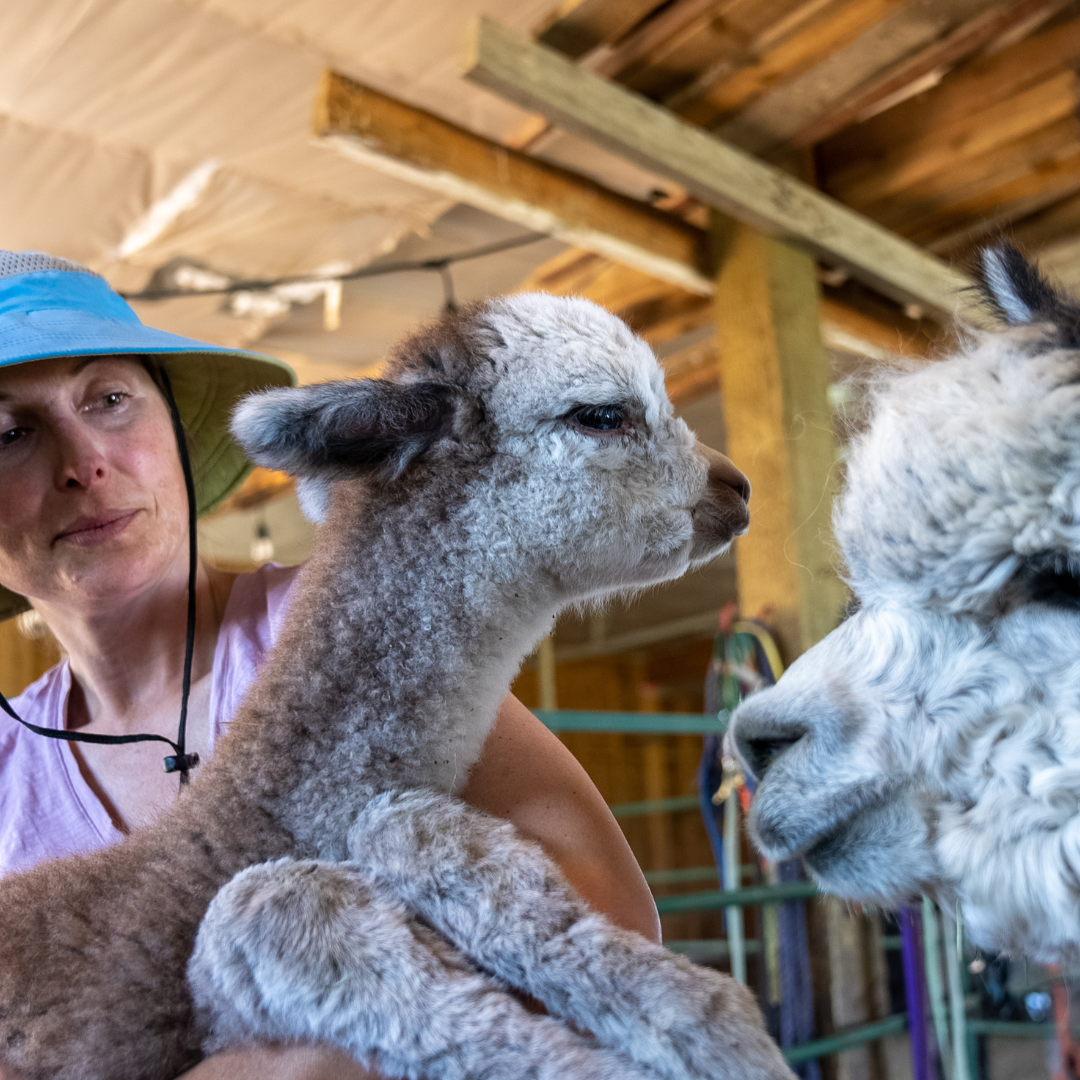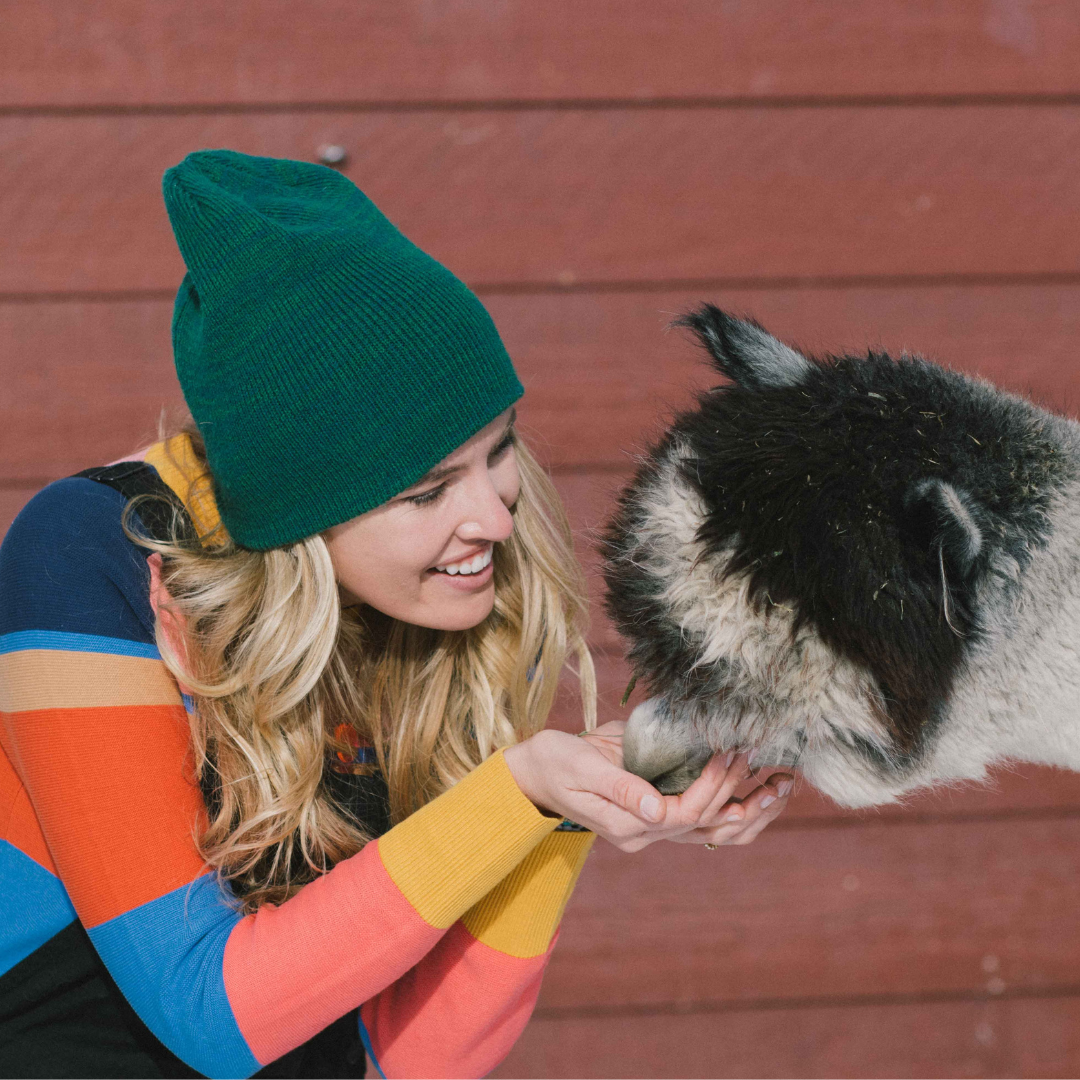FEEDING CRIA
Cria have no antibodies when born, and are unable to fight infection and disease. Cria obtain antibodies from their mother’s milk. The first milk is creamy sticky milk, called colostrum, with high levels of antibodies in it. A cria’s bowel can only absorb these antibodies in the first 12 to 24 hours of life. If a cria misses out on colostrums, it will be prone to infection.After a cria is born, we watch to make sure the mother is able to nurse the cria. We look for signs that they are receiving the milk and subsequent colostrum – sucking noises, tail in the air, a milk mustache. If they are running around and playing, they are receiving enough milk.
Make sure that the cria is feeding in the crucial first 24 hours.
Observe the feeding behavior – how often, and if satisfactory. If a cria is seeking milk, it will find it if it is there.
If your cria isnotfeeding, assist it.
|
|
| Alpaca Milk Moustache |
Ensure the dam's teats are clear of wax, and milk is flowing. The milk will flow better once the placenta is passed.
You may need to hold the cria under thedam, making sure it gets to the right place. If so, position yourself at the dam's rear legs, so when the dam turns around to check what is going on, it is her cria she sees and sniffs.
Milk from its own mother is ideal. You can milk an alpaca. But if milk is not available, the best alpaca supplementary feed is raw goat milk. Cow milk – whole and unpasteurized is second best.
You can use colostrum from, in order of priority, another alpaca or llama, an artificial substitute, or a cow, goat or sheep. It must receive colostrum before receiving milk.
Keep all equipment sterile.
Continue to monitor feeding. Indicators of poor feeding are frequent attempts to suckle (more than once an hour), weakness and lethargy, sitting a lot, poor weight gain or weight loss, and no milk moustache after feeding.
Monitor the progress of the cria. Weigh regularly – daily initially. Plot a chart of weights of all your cria, to notice any different growth patterns. Weigh them weekly until over 30 lbs.
The weight of the cria may drop by 10% in the first couple of days, but once the milk supply is fully in, cria weight gain should be 1/3 to ½ lb per day.
Cria are active, and move and play a lot.Day one they stay close to mom, day two they run away about 10 yards, and by day three they will explore 30-40 meters from mom.
Aim to feed the cria 10% of its body weight daily. Crias are snackers, needing frequent small feeds. Feed at 4 hourly intervals, with 6 feeds a day, from daybreak to late evening. You do not need to feed in the early hours of the morning, as alpacas sleep then.
As an example, a 15 lb cria gets a minimum of 600 mls a day, in 6 feeds of 100 ml.
A plastic bottle with aPritchard Nipple, is suitable for cria feeding. Keep all cria feeding equipment sterile, as you would for a human baby, using boiling water and a disinfectant.
An exception to thisfeeding regimeis very small frail cria. They may need feeding every 1.5 to 2 hours, around the clock, for the first three days. Get specialist advice and assistance.
Cria head for dark areas to nurse,like shed corners. Put a light on in a shed, so the darkest spot is under mother, as it would be in the paddock.
I find it easiest to achieve this posture by straddling the cria, restraining it with my knees, and having one hand to guide its head back towards me and one hand to hold the bottle.
Make sure the cria sucks, so the milk goes down the throat, not squirted into its airways. Keep the air hole in the base of the teat on the upper side for air to go in and help the milk to go out.
Poor suckers can be assisted to drink. Pop your finger in its mouth, and then slide the teat in. Hold its mouth closed and slowly stroke its throat to encourage it to swallow. This may take three hands initially (a second person to do the throat stroking), but it is possible with two hands.
Cria that will not suck can be stomach tube – often a job for your vet.
Keep the cria with its mother, and encourage it to feed from her – most prefer mom, and may even run to have a snack from their mother after the less palatable human-provided milk. Cria will eventually reject the bottle if mom is feeding them enough.
Keep the cria with its mother, and encourage it to feed from her – most prefer mom, and may even run to have a snack from their mother after the less palatable human-provided milk. Cria will eventually reject the bottle if mom is feeding them enough.
Bottle fed cria should be kept with the herd, to minimize them imprinting on the human feeder. It is tempting to pat and cuddle them, but this can cause problems later as they come into adolescence and adulthood, when they show no respect for the human that helped them survive.
CRIA FEEDING KIT
Plastic bottle – small soft drink 500ml size with screw thread
|
|
| Pritchard Nipple |
Pritchard Nipplewith a flutter valve - the air hole with ball bearing in it
Raw goat milk - best substitute milk
Plastic Bottle - Soda bottle, Propel Water Bottle
Plastic Bottle - Soda bottle, Propel Water Bottle
Glucose - for extra energy and sugar
Measuring jars to shake and make up milk
Funnel and strainer (ensure no lumps)
Bottle brush, bowl, and disinfectant solution
Colostrum substitute in fridgeOR
Colostrum frozen in freezer in small quantities like ice cube tray
Electrolyte solutions - for hydration
Thermometer – take temperature at almost every feeding
Comments, Questions, or Something to add? Let me know.
Comments, Questions, or Something to add? Let me know.


























































































